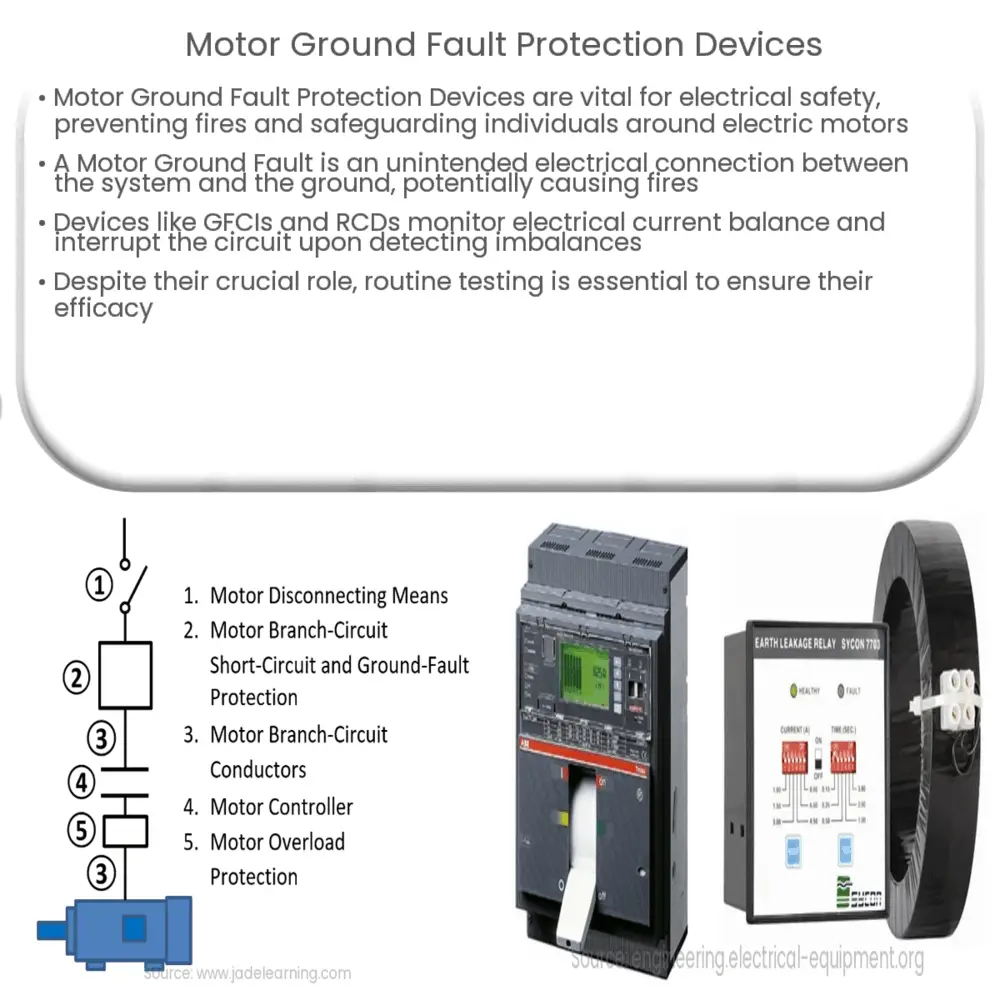Explore the role and importance of Motor Ground Fault Protection Devices in electrical safety, their working principle, types, installation, and limitations.

Introduction to Motor Ground Fault Protection Devices
The importance of electrical safety cannot be overstated, and the role played by Motor Ground Fault Protection Devices is central to it. These devices help prevent electrical fires, damage to motors, and ensure the safety of individuals working with or around electric motors.
What is a Motor Ground Fault?
A Motor Ground Fault is an undesirable electrical connection between the electrical system (usually the motor winding) and the ground. Under normal conditions, there should be no connection between these two. However, insulation breakdown, moisture, contamination, or physical damage can lead to the establishment of this unintended connection. The immediate consequence is the flow of fault current to the ground, which can lead to catastrophic results including fires and motor destruction.
Working Principle of Ground Fault Protection Devices
Motor Ground Fault Protection Devices, often called Ground Fault Circuit Interrupters (GFCIs) or Residual Current Devices (RCDs), work by continuously monitoring the balance of electrical current entering and leaving the circuit. Under normal operating conditions, the amount of current flowing in should equal the amount flowing out. In the event of a ground fault, a portion of the current will deviate from the intended path, creating an imbalance. The protection device detects this imbalance and quickly interrupts the circuit, effectively stopping the flow of electricity, thereby minimizing the risk of damage and danger.
Types of Motor Ground Fault Protection Devices
- Ground Fault Circuit Interrupters (GFCIs): These devices are designed to protect individuals from electric shock. They work by comparing the input current on the hot side to the output current on the neutral side. If an imbalance is detected, the GFCI will trip the circuit within a fraction of a second.
- Residual Current Devices (RCDs): Similar to GFCIs, RCDs are designed to protect against fatal electric shocks and reduce the risk of electrical fires. RCDs work by continuously comparing the current flowing into the circuit with the current flowing out. Any detected imbalance would cause the device to cut the power.
Overall, the importance of Motor Ground Fault Protection Devices in the realm of electrical safety is monumental, not only safeguarding expensive equipment but also preserving human lives.
Installation and Maintenance of Motor Ground Fault Protection Devices
Ground fault protection devices are typically installed in the electrical distribution panel. Some versions are designed to replace the standard circuit breaker, while others can be added to existing circuits. Despite their critical role, these devices require relatively little maintenance. However, a monthly test is often recommended to ensure they are functioning correctly. This can usually be performed by pressing the ‘test’ button on the device, which should trigger an interruption in the circuit.
Factors to Consider when Choosing a Motor Ground Fault Protection Device
- Motor Type and Size: Different motors have different requirements. Large motors may require more specialized and robust protection devices.
- Environment: The environment in which the motor operates can influence the choice of device. Moist, dusty, or chemically aggressive environments may require specific types of protection.
- Regulatory Compliance: Ensure that the chosen device complies with all local and national electrical codes and standards.
Limitations of Motor Ground Fault Protection Devices
While Motor Ground Fault Protection Devices provide a robust level of protection, they do have some limitations. For example, they might not protect against line-to-line faults, such as when insulation breaks down between two conductors. Also, GFCIs and RCDs can’t protect someone from an electrical shock if the person comes in contact with both the live and neutral conductor at the same time. Therefore, these devices should be part of a comprehensive safety system that includes proper equipment design, installation, and maintenance.
Conclusion
In conclusion, Motor Ground Fault Protection Devices form an essential part of any electrical system involving motors. They provide a valuable layer of protection against potentially dangerous ground faults, safeguarding both human lives and equipment. While they have some limitations, their benefits far outweigh the drawbacks. Selecting the right protection device requires consideration of factors such as motor type, operating environment, and regulatory compliance. Routine testing and maintenance of these devices are crucial to ensure their efficacy in providing continuous protection. Thus, it is imperative to understand and appreciate the role these devices play in our daily safety and the seamless operation of electrical systems.

